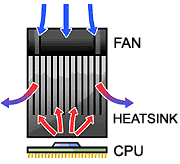Cooling 101: Introduction
The following pages are intended to provide you with a better understanding of Koolance products and liquid cooling in general.
- Introduction
- The Basics of Heat Transfer
- Thermal Interface Compound
- Liquid Cooling Design
- CPU Cooler
Hot Gets Hotter
As transistor sizes continue to decrease, chip manufacturers pack even more on to the processor. In 1992, a 486/DX2 66Mhz CPU consumed about 7W of power (with 1.2 million transistors). It didn't even require a cooling fan. Today, processors can range from 50-200W depending upon the core type and load.
Most high-end video cards now exceed the total power consumption of today's processors. Other components have also followed this tendency toward higher heat outputs with each consecutive generation.
Koolance has long believed liquid to be the next evolutionary phase in computer cooling systems. Major processor and video card manufacturers have been devising water-based concepts for years, anticipating the point when air cooling would simply reach its limit.
Why Liquid?

Heat-producing devices in a typical computer are cooled by air. Generally, this involves mounting a heat sink and fan to each component. Heat generated from your CPU is transferred into a metal heat sink, where a fan blows air across its wider surface area.
While altering a heat sink's size and makeup can improve the effectiveness, it is still limited because air absorbs and transfers heat very slowly. To help counteract this, the fan can be run at a higher speed, but most people know what that means: high performance has become equated with high noise. As systems continued to be upgraded, required heat sinks got larger and louder.

Of liquids, water (after mercury) conducts heat the fastest. Its thermal conductivity is about 30 times greater than that of air. And not only that, it holds a lot more heat. It takes over 4 times as much heat to raise the temperature of water as it does air.
These basic physical attributes give liquid cooling a considerable advantage in cooling, but the benefits don't end there.


Stay Connected